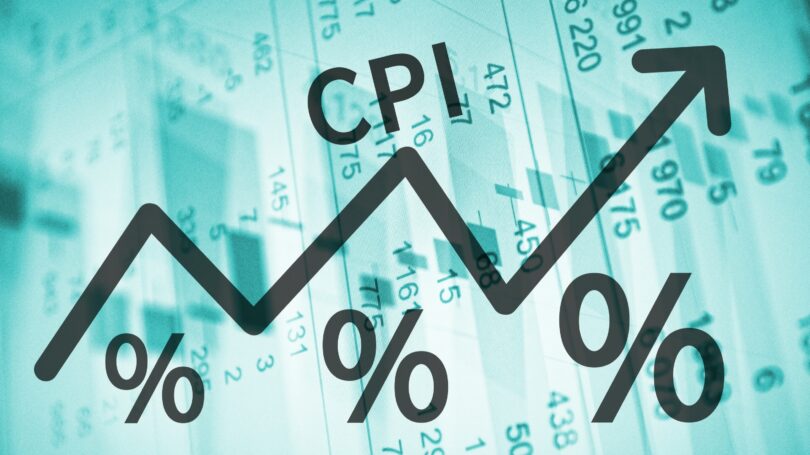The Consumer Price Index, or CPI, increasingly affects Americans of all ages, incomes, and location. Yet few citizens understand how it’s calculated, how it’s used, or its strengths and shortcomings.
The CPI is one of the most important figures calculated by the Bureau of Labor Statistics (BLS). It reflects the rate of inflation that has occurred from one period to another, allowing you to understand why your dollars buy less today than yesterday. The Federal Reserve uses the index to set monetary policy, and Congress considers it when determining cost-of-living adjustments to federal benefits and taxes.
Here’s what you need to know to understand the CPI and how it affects our nation’s economy – and your bottom line.
What Is the CPI?

Simply stated, the Consumer Price Index is a weighted measure of the change in prices paid by typical consumers for a representative collection of goods and services over time. The BLS uses a combination of sampling data and statistical analysis to establish the price for a fixed category of goods and service consumed by a family unit during a specific period. A comparison of the index price for two calendar dates provides a close approximation of inflation between the two periods.
Three separate, though related, Consumer Price Indexes are published each month:
- CPI for All Urban Consumers (CPI-U). This figure represents the buying habits of urban and metropolitan residents. It does not include rural workers, those living outside the Metropolitan Statistical Area (MSA), military personnel, or those in institutions such as prisons and hospitals.
- CPI for Urban Wage Earners and Clerical Workers (CPI-W). This index, while using the same price data, is a smaller set of the CPI-U population that includes clerical, sales, service, and construction workers, along with laborers. Not included in this calculation are professional and salaried workers, retirees, part-time workers, and the self-employed and unemployed.
- Chained CPI for All Urban Consumers (C-CPI-U). The Chained CPI, created in 2002, is based on the economic premise that consumers substitute higher-priced items with similar products at lower prices. In other words, consumers accept lower quality for lower costs. This index uses the same population and purchased items as the CPI-U but adjusts it to reflect the lower-priced substitute goods and services. As a consequence, the C-CPI-U is always lower than the CPI-U.
In addition to the three main CPI indexes, the BLS publishes monthly or bimonthly subsets of indexes appropriate to specific regions and MSAs, as well as select products and services for the CPI-U and CPI-W.
History of the CPI
The forerunner of the CPI, the Cost-of-Living Index, was created to help resolve labor unrest following World War I. Due to the war, prices of goods increased by almost 19% per year from 1917 to 1919, while wages stagnated. As a consequence of labor problems, especially in shipbuilding cities, the Shipbuilding Labor Adjustment Board and the National War Labor Board directed the BLS to develop a cost-of-living index that included “food, clothing, rent, fuel and light, furniture and miscellaneous goods.”
Under the Department of Labor, the BLS developed and reported the Cost-of-Living Index for the first time in 1919. It was a semi-annual summary of price data for certain goods and services (a “market basket”) purchased by wage-earning families in 32 cities, and it was intended to represent the cost of living for average industrial wage-earners in each urban area. Comparing indexes from different dates or separate cities provided the relative wage increase necessary to maintain the same standard of living from period to period or in one town versus another.
In 1935, the BLS introduced its initial version of the CPI, which calculated more items and combined the data from individual cities to develop a single composite figure. In subsequent years, the collected information has been modified and expanded to better represent a typical urban consumer and the change in the value of the dollar for the country as a whole.
While the CPI is commonly referred to as the Cost-of-Living Index, the CPI cannot be used to compare living costs from one area to another. The federal government no longer publishes an official Cost-of-Living Index. However, such comparisons are readily available from private sources, including national real estate firms and relocations specialists.
How the CPI Is Calculated

While the process behind the CPI is easy to understand, the procedure to calculate the measure requires extensive data collection, sophisticated sampling techniques, and reliance on certain theoretical assumptions. The effort required to collect the data behind the calculations is extraordinary and continuous. The process includes:
- Constructing a “Market Basket.” Using data from Consumer Expenditure Surveys collected over two years, the BLS determines the identity and quantities of all of the goods and services purchased by a particular population – for example, all urban workers (CPI-U). The BLS then sorts these items into more than 200 categories and eight major groups: Food and Beverages, Housing, Apparel, Transportation, Medical Care, Recreation, Education and Communication, and Other Goods and Services. Excluded items include free goods or services – including those provided by the government at no cost – investments, life insurance, homes, or cash gifts to individuals or charities.
- Weighting Each Item in the Basket. The BLS assigns a particular percentage of total expenditures for the period to each item, thus fixing the items and their proportionate share of the costs of the market basket. The composition and percentage of the basket rarely change – this is known as in statistics as a “fixed-weight price index” – so that it’s easier to compare prices between different periods. When an adjustment in the market basket becomes necessary, the BLS substitutes an item most closely resembling the old product or service.
- Calculating the Costs of the Basket. The BLS collects market data on an estimated 80,000 items each month. Each item is tracked by BLS workers who call or visit thousands of retail stores and service companies to develop the average price for the month. Since the items and their cost percentages are fixed, the only variable from period to period is the price of the item. The sum of the change in prices for each item from one period to another reflects the total price change between periods.
- Computing the Consumer Price Index. A “base year” is needed to calculate the Index. The base year is the first year in a series and becomes the starting point for comparison with other years. The CPI in the base year is always equal to 1.0, or 100% of the cost of the market basket. While any past year can be used as the base year for calculation, the BLS currently uses the average index level of the period from 1982 to 1984. Chapter 17 of the BLS Handbook of Methods provides further explanation and examples of CPI computations.
The CPI & the Inflation Rate
For most purposes, the differences in the CPI from one period to the next are an adequate representation of inflation as it affects consumers through rising prices. Other indexes might be more accurate for purposes such as understanding how inflation affects the gross domestic product (GDP) (GDP Deflator), imports and exports (IPP), or wages and salary (ECI).
The inflation rate is the percentage increase in the prices of goods and services over time. It’s calculated by dividing the difference between the CPI for the base year and the comparison year by the CPI of the base year and multiplying the result by 100. The BLS provides an easy-to-use online calculator that does the heavy lifting for you. The calculator presents the difference in buying power from one period to another, which can easily be translated into an inflation rate.
For example, $1,000.00 in January 2010 has the same buying power as $1.161.64 in January 2019. To convert this information into the inflation rate, you would:
- Determine the difference between the buying power at each date: $1,161.64 – $1,000.00 = $161.64
- Divide the difference ($161.64) by the initial buying power ($1,000.00) and multiply by 100 to determine the inflation rate during the period: ($161.64 ÷ $1,000.00) x 100 = 16.164%
How Is the CPI Used?

The CPI affects millions of citizens and non-citizens through its use as an economic indicator and a payment escalator in collective bargaining agreements, personal employment contracts, long-term real estate and equipment leases, and government assistance programs.
1. Economic Indicator
The CPI is the most popular and vital index used to measure inflation and is especially important in the administration of governmental monetary and fiscal policies.
- Monetary Policy. Administered through the Federal Reserve System, monetary policy regulates the country’s money supply – in other words, how much money people have to spend, otherwise known as demand. The Fed’s policy tools include setting interest rates and buying and selling government debt.
- Fiscal Policy. Congress and the president establish the budgetary policy of the United States by their decisions about taxes and government spending. High taxes and low spending slow economic growth, while low taxes and high spending promote GDP increases.
At times, the two policies can conflict, such as when the Federal Reserve raises interest rates and Congress increases government spending. Ideally, both systems are in sync, either trying to slow the rate of inflation or avoid the calamity of a depression.
Economies rarely are stable, cycling between periods of inflation (more money than goods, causing price increase) and deflation (more goods than money, causing price decreases). Too much of either can have devastating effects on a country’s economy as measured by GDP:
- Inflation. Historically, the Federal Reserve has tried to keep inflation around 2% annually. Most economists believe a low level of inflation is positive for growth as consumers with more cash are likely to increase their consumption of goods and services. The increased sales encourage businesses to invest in equipment and employees for higher productivity and profits. Even though prices increase through higher demand for products – in other words, demand exceeds supply – the increase is relatively mild. At the same time, excessive inflation, sometimes referred to as “galloping” or “hyperinflation,” when price increases exceed 10% annually, can wreck economies and topple governments.
- Deflation. When the demand for goods and services is less than their supply, prices fall. Consumers are more likely to hoard their money, expecting further reductions in the future. The drop in sales leads to cycles of increased unemployment and business failures. During the Great Depression, global GDP fell by 15%, industrial production by 46%, and foreign trade by 70%, while unemployment rose as high as 33% globally and 25% in the United States.
Of the two conditions, deflation is the most devastating since there are limits to the measures the government can use to encourage growth; it can’t decrease interest rates below zero, for example. Without the information provided by the CPI and similar indexes, any attempt to control inflation or deflation might be impossible.
2. Payment Escalator
Collective bargaining agreements between groups of workers and employers typically cover multiple years. An automatic semi-annual or annual increase in the basic wage – a process known as “indexing” – maintains the purchasing power negotiated in the contract. The adjustment is referred to as the Cost-of-Living Adjustment, or COLA.
The CPI is also used as a method to increase payment amounts for a variety of long-term contracts, including real estate and equipment leases. For example, building contractors are especially vulnerable to unanticipated increases in material costs during longer-term projects. As a consequence, contractors frequently include an automatic increase in contract payment terms if the CPI exceeds a certain level. As Frank Rebori, vice president of a wastewater treatment equipment manufacturer, explains on WaterWorld, “When an escalation clause is utilized, the bids received may be more in line with current and reasonably expected future prices. This takes away the bidders’ need to drive up their proposals to account for some future unknown variable.”
Many federal and state welfare and entitlement programs include provisions for automatic increases in benefit amounts based on changes in the CPI:
- Federal Welfare Programs. Of the six federal welfare programs – Temporary Assistance for Needy Families (TANF), Medicaid, Child’s Health Insurance Program (CHIP), Supplemental Nutrition Assistance Program (SNAP), the Earned Income Tax Credit (EITC), and the Housing Choice Voucher Program – only SNAP and the EITC are indexed for inflation. Congress and state governments establish funding and benefits for the other programs.
- Federal Entitlement Programs. Only those who have made contributions through payroll taxes are eligible for these programs – namely, Social Security, Medicare, unemployment insurance, and worker’s compensation. Generally, both premiums and benefits are escalated to account for inflation.
3. The CPI & Taxes
In 1981, Congress passed the Economic Recovery Act, which mandated increases in personal exemption and standard deduction amounts and widened tax brackets in line with the CPI increase. The Tax Reform Act of 1986 reaffirmed indexing. In 2016, the Institute on Taxation and Economic Policy found more than 40 provisions in the tax code that are tied to inflation.
While the mandated escalation continues under the Tax Cuts and Jobs Acts of 2017, the new law substituted the C-CPI-U for the previously used CPI-U. Bloomberg Opinion called the change a “Big, Permanent Tax Increase” whose regressive nature will affect taxpayers in the lower brackets the most. That’s because inflation increases the dollar amount of income without a similar increase in purchasing power. The increase in income forces taxpayers into higher income tax brackets, meaning they pay more taxes even though their dollars have less purchasing power.
Fourteen of the 34 states with income tax brackets also employ indexing with the CPI, according to the Tax Foundation. Nevertheless, property tax rates, homestead exemption levels, and excise tax rates generally remain fixed, even though the underlying asset increases by inflation every year and generates more tax income. This practice allows politicians to implement an “inflationary tax hike” without arousing the voter backlash typical to explicit tax increases.
Indexing, when adequately implemented, preserves the purchasing power taxpayers might otherwise lose through taxation. Without indexing, a salary increase reflecting a cost-of-living adjustment could push a taxpayer into a higher tax bracket and result in lost purchasing power. Inflationary tax increases disproportionately affect low- and middle-income earners due to the narrower brackets on the low end of the tax bracket schedule.
4. The CPI & Social Security
In 1973, Congress passed Public Law 92-336 amending the Social Security Act of 1935 to add an automatic cost of living increases based on the CPI-W. The increase is calculated by:
- Taking the difference between the average CPI-W for three months of the third quarter of the current year and the average CPI-W for three months of the third quarter of the last year a COLA adjustment was made
- Dividing that difference by the CPI of the last year a COLA adjustment was made, multiplied by 100
For example, the average CPI-W for 2017 and 2018 was 239.668 and 246.352, respectively. Rounded to the nearest one-tenth of 1%, the increase for 2018 is: (246.352 – 239.668) ÷ (239.668 x 100) = 2.8%.
Concerns about the future viability of Social Security have increased in recent years. Various reforms to the program have been suggested, but no significant changes have been enacted. One common proposal is to substitute the C-CPI-U for the currently used CPI-W used to calculate COLA increases. That would cut costs since the former is always a lower percentage rate. If the substitution is implemented, reduced payments would equal an estimated $116.4 billion between 2016 and 2026, according to a Congressional Budget Office report. This proposal is politically controversial, with opponents ranging from the AARP to conservative anti-tax organizations.
Some have proposed a new CPI for Social Security COLA calculations, the Consumer Price Index for the Elderly (CPI-E), which would use the same market basket of products and services but apply a different rating system to reflect the spending habits of those ages 62 and up. While this substitution would increase the annual payout to retirees, it would drain the Social Security Trust Fund faster than the current CPI-W.
Criticisms of the CPI as an Inflation Indicator

The Consumer Price Index is frequently criticized for overestimating inflation, primarily due to the fixed composition of market baskets. Critics claim that the calculation doesn’t adequately account for consumers regularly substituting goods and services of lesser or higher quality than those identified in a market basket. All price indexes have a similar shortcoming with their inability to deal with quality variations or new technologies.
What critics fail to recognize is that the CPI is, by necessity, an average representing a composite of consumers across the nation. It’s possible – even probable – that the cost of living rises at different rates for different consumers. As a result, the assumed characteristics and consumption patterns of any particular group of consumers are unlikely to represent those of a specific individual accurately.
The Federal Reserve Bank of New York, responding to the attacks on the CPI, stated that the alternatives “have substantive problems of their own, suggesting that the CPI, though flawed, is still our most reliable indicator of changes in inflation.”
Final Word
In 2019, America celebrates the CPI’s 100th birthday. In the past century, the techniques and theories supporting the CPI have changed to better represent a typical family in a modern world. Nevertheless, the index is discussed – and cussed – in the halls of government and academia as well as at the family dinner table, where parents wonder why they keep exceeding their budgets.
Nevertheless, even the most vociferous opponents of the measure agree that the information provided by the CPI leads to a less volatile economy, reduced labor and social unrest, and stable government assistance programs.
Have you considered the effect of inflation on your income and cost of living? Do you have any suggestions to make the CPI more representative of the average citizen’s experience?